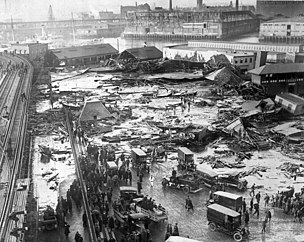Shays’ Rebellion started formally in 1786. Daniel Shays and other farmers in central Massachusetts were revolting against high taxes and debt policies. At that time if people could not pay their debts, they were put in prison. The resistance was broken around February 1787, and the last vestiges concluded in June 1787. Some experts believe that Shays’ Rebellion influenced members of the Constitutional Convention. Older children could learn more at: Shays’ Rebellion.
Mayflower set sail in 1620 with 102 passengers and a meager crew. Its destination was Jamestown in Virginia, but it encountered terrible storms and was blown off course. It arrived at what is now Provincetown, Massachusetts, on November 21, 1620. The passengers went ashore at Plymouth, Massachusetts, on December 26, 1620. Children could read On the Mayflower by Kate Waters. They could also visit: Mayflower.

Ball Point Pens
Ballpoint pen was patented in 1888 by John J. Loud of Weymouth, Massachusetts. He received patent number 392,046. A lawyer, inventor, and tanner, he developed the instrument so that he could write on his leather products. Fountain pens, then the most used type of pen, could not write on leather. Loud’s ballpoint pen, however, was not successful when used on paper. Laszlo Biro created a commercially successful ballpoint pen in 1943. Children can view Loud’s patent at: Ballpoint Pen Patent.
Mayflower dropped anchor in Cape Cod, Massachusetts, and the Mayflower Compact was signed in 1620. This brief but extremely important document, reproduced below, was one of the first steps toward democracy.
In the name of God, Amen. We, whose names are underwritten, the loyal subjects of our dread Sovereign Lord King James, by the Grace of God, of Great Britain, France, and Ireland, King, defender of the Faith, etc.
Having undertaken, for the Glory of God, and advancements of the Christian faith and honor of our King and Country, a voyage to plant the first colony in the Northern parts of Virginia, do by these presents, solemnly and mutually, in the presence of God, and one another, covenant and combine ourselves together into a civil body politic; for our better ordering, and preservation and furtherance of the ends aforesaid; and by virtue hereof to enact, constitute, and frame, such just and equal laws, ordinances, acts, constitutions, and offices, from time to time, as shall be thought most meet and convenient for the general good of the colony; unto which we promise all due submission and obedience.
In witness whereof we have hereunto subscribed our names at Cape Cod the 11th of November, in the year of the reign of our Sovereign Lord King James, of England, France, and Ireland, the eighteenth, and of Scotland the fifty-fourth, 1620.
Anne Hutchinson was exiled from Massachusetts in 1637 for speaking against the religious leaders. She, her husband, and others traveled to join Roger Williams in Providence, Rhode Island. Anne Hutchinson’s Way, written by Jeannine Atkins and illustrated by Michael Dooling, accurately portrays Hutchinson’s life and the problems she faced. Older children could learn more at: Anne Hutchinson.

Boston Molasses Disaster
Boston Molasses Disaster occurred in 1919. No, this is not a hoax; this was a terrible disaster. On this day in 1919 a huge tank holding about 2,300,000 gallons of molasses ruptured, sending a tsunami of molasses into the streets of the North End part of Boston. Moving at 35 miles per hour, the molasses wave leveled buildings, trapped people, and even hurled a truck into Boston Harbor. About 21 people died, and 150 more were injured. Children could read The Great Molasses Flood by Deborah Kops. They could also watch a very interesting video at: Boston Molasses Disaster.
 Polar bear was put on display in Boston, Massachusetts, in 1733. Idea: Children could discuss why this would be a very big event for that time period. Carnivores, polar bears are becoming rare. Today scientists estimate 20,000 to 25,000 polar bears exist. Experts believe that by 2050 that number will be cut in half. Children can learn more about polar bears and see some great photos at: Polar Bears. Interesting coincidence – Raymond Briggs, born on January 18th, wrote a book in 1994 about a polar bear called The Bear. It was made into a short animated video.
Polar bear was put on display in Boston, Massachusetts, in 1733. Idea: Children could discuss why this would be a very big event for that time period. Carnivores, polar bears are becoming rare. Today scientists estimate 20,000 to 25,000 polar bears exist. Experts believe that by 2050 that number will be cut in half. Children can learn more about polar bears and see some great photos at: Polar Bears. Interesting coincidence – Raymond Briggs, born on January 18th, wrote a book in 1994 about a polar bear called The Bear. It was made into a short animated video.
Paper money was used for the first time in 1690 in the colony of Massachusetts. Idea: Children could debate the pros and cons of using paper money as opposed to coins. They can visit the Bureau of Printing and Engraving site: Paper Money.
Roger Williams landed in America in 1631. He came for religious freedom, but he found the Massachusetts colony restrictive. Banished by Massachusetts leaders in early 1636, he founded the colony of Rhode Island and the city of Providence. Children can learn more at: Roger Williams.

Massachusetts State Flag
Massachusetts became the sixth state in the United States by ratifying the Constitution in 1788. The word Massachusetts means, “at or about the great hill.” The state ranks forty-fifth in size and thirteenth in population. Its state beverage is cranberry juice. They could toast Massachusetts’s birthday with cranberry juice.